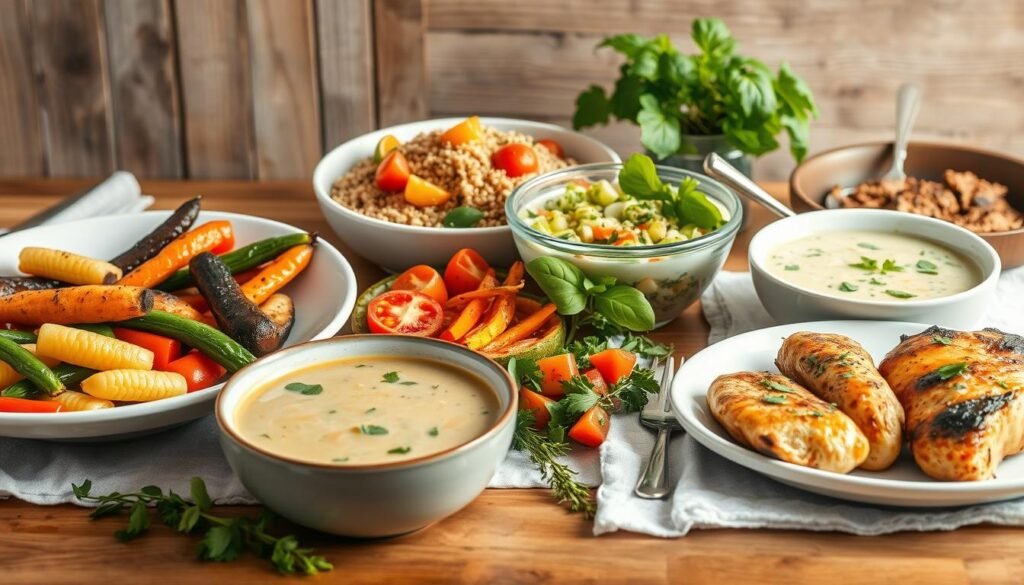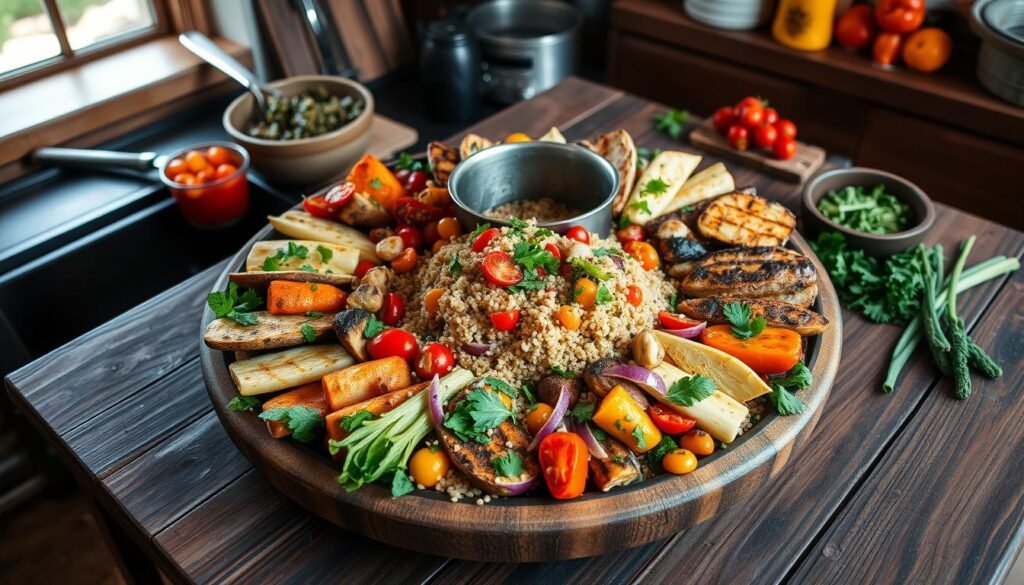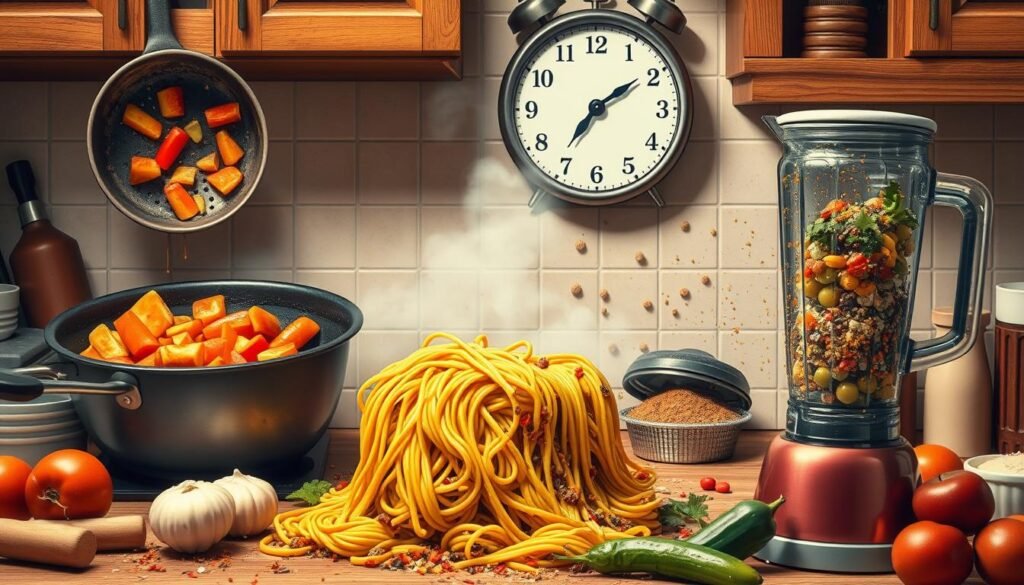
Cooking healthy doesn’t have to be hard or take a lot of time. Our easy low-calorie dinner recipes make it simple to prepare tasty meals for tonight. We want to help you start cooking healthier with recipes that are low in calories and quick to make.
If you’re new to cooking or looking for new ideas, we’ve got you covered. Our guide will show you how to make healthy, tasty meals. We’ll teach you about low-calorie cooking and share easy cooking tips.
We believe in making healthy eating a lifestyle. With our low-calorie recipes and easy cooking tips, you can make delicious, healthy meals. Start your journey to a healthier, happier you with our healthy recipes and easy cooking methods.
Introduction to Healthy Cooking
In this section, we talk about low-calorie cooking and why it’s good for you. We’ll cover using fresh ingredients, controlling how much you eat, and swapping ingredients to cut calories. By following these tips and using our recipes, you can make healthy, tasty meals.
Key Takeaways
- Low-calorie dinner recipes can be easy and delicious
- Healthy recipes are essential for a balanced diet
- Easy cooking techniques can make healthy eating a breeze
- Controlling portion sizes is crucial for weight management
- Smart ingredient swaps can reduce calorie intake
- Low-calorie cooking can be a sustainable lifestyle choice
Understanding the Basics of Low-Calorie Cooking
To cook low-calorie meals, you need to know the basics. This means learning about macronutrients like carbs, proteins, and fats. These nutrients affect a meal’s calorie count. Also, portion control and balancing food groups are key.
Having the right kitchen tools is important for low-calorie cooking. You’ll need a food scale, measuring cups, and a non-stick pan. These tools help you measure and prepare ingredients accurately.
Key Principles for Low-Calorie Cooking
When cooking low-calorie meals, remember to balance carbs, proteins, and fats. Aim for 45-65% carbs, 20-35% fats, and 10-35% proteins. This balance helps make meals nutritious and tasty.
Essential Nutritional Principles
- Balance carbohydrates, proteins, and fats in meals
- Control portion sizes to manage calorie intake
- Choose whole, unprocessed foods whenever possible
By following these principles and using the right tools, you can make healthy, tasty meals. This is great for weight management or a healthier lifestyle. Learning the basics of low-calorie cooking is a big step towards success.
| Nutrient | Recommended Daily Intake |
|---|---|
| Carbohydrates | 45-65% of daily calories |
| Fats | 20-35% of daily calories |
| Proteins | 10-35% of daily calories |
Easy Low-Calorie Dinner Recipes for Busy Weeknights
Busy weeknights need quick recipes. These weeknight meals are fast to make. They help you eat healthy without losing flavor.
Here are some tips for quick recipes on busy weeknights:
- Plan your meals in advance to avoid last-minute takeouts or fast food.
- Keep a stash of healthy ingredients, such as lean proteins, whole grains, and frozen vegetables.
- Use one-pot wonders or 30-minute meals to save time on cooking and cleanup.
Some examples of low-calorie dinner ideas include:
- Grilled chicken with roasted vegetables
- Quinoa and black bean bowls with avocado salsa
- Baked salmon with brown rice and steamed broccoli
These weeknight meals are tasty and full of nutrients. They’re quick to make. Adding these quick recipes to your meals keeps you healthy, even on busy days.
Healthy eating doesn’t have to be hard or take a lot of time. With these low-calorie dinner ideas, you can have a tasty, healthy meal. You won’t lose out on flavor or convenience.
| Recipe | Calories | Prep Time |
|---|---|---|
| Grilled Chicken with Roasted Vegetables | 350 | 20 minutes |
| Quinoa and Black Bean Bowls with Avocado Salsa | 400 | 25 minutes |
| Baked Salmon with Brown Rice and Steamed Broccoli | 300 | 15 minutes |
Protein-Packed Options Under 400 Calories
High protein recipes are key for energy and health. There are many tasty, healthy meals to choose from. They don’t have to be heavy on calories.
Lean meats like chicken, turkey, and pork tenderloin are great. You can mix them with veggies and grains for a full meal. Seafood like salmon, shrimp, and cod are also packed with protein. You can bake, grill, sauté, or stir-fry them.
Exploring Plant-Based Protein
Plant-based meals are a good choice for more protein. Legumes like lentils, chickpeas, and black beans are full of protein and fiber. Tofu and tempeh are also great for protein. They can be marinated and cooked in many ways.
Benefits of Protein-Rich Meals
Protein-rich meals help muscles grow and repair. They also aid in weight management. Choose meals with lean meats, seafood, and plant-based proteins for health and taste.
- Grilled chicken breast with roasted vegetables
- Baked salmon with quinoa and steamed broccoli
- Lentil soup with whole grain bread
These meals are not just high in protein. They’re also full of other important nutrients. They’re perfect for keeping you healthy and happy.
Veggie-Forward Dinner Ideas That Satisfy
Vegetables are key to a healthy diet. They give us important vitamins, minerals, and fiber. There are many vegetable recipes to try. They make veggie-forward meals that are tasty and good for you.
Some tasty low-calorie dinner ideas are vegetable stews, salads, and roasted veggies. These dishes let veggies shine. They make your meal special.
https://www.youtube.com/watch?v=u7iIJ3vjjSA
- Try different seasonings and spices to make your dishes tasty.
- Use a mix of colorful veggies for more nutrients.
- Add plant-based proteins and whole grains for more flavor and texture.
Follow these tips to make low-calorie dinner ideas that are both healthy and tasty. You can make a big, satisfying stew or a fresh salad. Vegetable recipes will help you make a meal that’s good for you and delicious.
| Meal Idea | Calories | Prep Time |
|---|---|---|
| Roasted Vegetable Soup | 200 | 30 minutes |
| Grilled Vegetable Salad | 250 | 20 minutes |
| Stuffed Bell Peppers | 300 | 40 minutes |
Smart Ingredient Swaps for Lower Calories
Changing a few ingredients can cut down a lot of calories in your meals. By using low-calorie swaps, you can make healthier versions of your favorite dishes. This way, you can eat tasty food without too many calories.
For example, use cauliflower instead of pasta. Choose low-fat cream and sauce options. And pick natural sugars over refined ones. These swaps can greatly improve your meal’s health.
Pasta Alternatives
Pasta can have a lot of calories. But, there are better choices. Try zucchini noodles or spaghetti squash. They’re low in calories.
Shirataki noodles are also good. They’re made from konjac plant roots and have almost no calories.
Cream and Sauce Substitutions
Cream and sauce can add a lot of calories. But, you can find better options. Use Greek yogurt or cottage cheese instead of sour cream.
Go for tomato-based sauces over creamy ones. This can help cut down calories.
Natural Sugar Replacements
Refined sugars have a lot of calories and aren’t good for you. Try honey or maple syrup instead. They’re natural and sweet.
Stevia or erythritol are also good. They’re low-calorie and don’t raise blood sugar.
One-Pan Low-Calorie Meals for Easy Cleanup
For a stress-free dinner, try one-pot recipes. They are easy to clean up and healthy. They’re great for busy homes, mixing healthy eating with less cleanup.
Some low-calorie meals in one pan are:
- Grilled chicken and vegetable stir-fry
- Baked salmon with roasted vegetables
- One-pot pasta with lean ground turkey and tomato sauce
These one-pot recipes taste great and are easy to clean. They’re perfect for weeknight dinners. They help you eat healthy and save time on cooking.

With a little creativity, you can make many one-pot recipes. They are healthy and tasty. They make mealtime easy, whether you’re busy or have kids.
| Recipe | Calories per serving | Cooking time |
|---|---|---|
| Grilled chicken and vegetable stir-fry | 350 | 20 minutes |
| Baked salmon with roasted vegetables | 400 | 25 minutes |
| One-pot pasta with lean ground turkey and tomato sauce | 450 | 30 minutes |
Meal Prep Strategies for Weight Management
Meal prep is key for managing weight. It means planning and making meals ahead of time. This way, you can eat healthy and balanced.
One important part of meal prep is portion control. It’s vital to eat the right amount of food. Here are some tips:
- Eat smaller, frequent meals throughout the day
- Use a food scale to measure your food portions
- Choose smaller plates to help control your food intake
Make-ahead recipe ideas are also helpful. Making meals early saves time. You’ll have healthy food ready when you need it. Soups, salads, and grilled meats are great options.
It’s important to store and reheat meals safely. Here are some tips:
| Food Type | Storage Guidelines | Reheating Guidelines |
|---|---|---|
| Cooked meats | Store in airtight containers in the refrigerator | Reheat to an internal temperature of 165°F (74°C) |
| Cooked vegetables | Store in airtight containers in the refrigerator | Reheat to an internal temperature of 165°F (74°C) |
By using these meal prep tips, you can manage your weight better. Always remember to control portions, use make-ahead recipes, and follow safe food handling.
Common Mistakes to Avoid When Cooking Light
When you cook light, it’s easy to make mistakes. These mistakes can hurt the taste and health of your food. Knowing these mistakes helps you cook better and eat healthier.
Some common mistakes to avoid include:
- Overrelying on processed foods, which can be high in calories and low in nutrients
- Neglecting the importance of flavor, which can lead to bland and unappetizing meals
- Not paying attention to portion sizes, which can result in consuming more calories than intended
By avoiding these mistakes, you can get better at cooking light. You’ll make tasty, healthy meals that help you stay on track with your diet.

Remember, the secret to good light cooking is using whole, healthy foods. Be creative with flavors and ingredients. With time and practice, you’ll make healthy meals that you’ll love eating.
| Mistake | Solution |
|---|---|
| Overrelying on processed foods | Focus on whole, nutrient-dense foods |
| Neglecting the importance of flavor | Experiment with herbs and spices to add flavor to your meals |
| Not paying attention to portion sizes | Use a food scale or measuring cups to measure your food portions |
Conclusion: Making Healthy Eating a Sustainable Lifestyle
As we wrap up our look at low-calorie recipes and healthy eating, remember it’s more than a diet. It’s about living a lifestyle that makes you feel good. The tips and recipes here are a start, but it’s your dedication that really matters.
Try out these low-calorie dinner ideas in your meal plans. They can lead to new tastes and ingredients. Eating well not only helps with weight but also makes you feel good about food. Healthy eating is a journey, so enjoy the ride and keep exploring.
